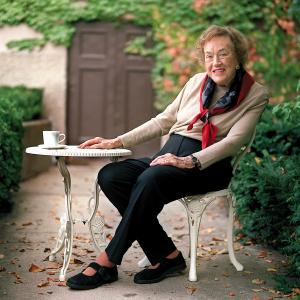Issue Date: September 26, 2003
By DIANE FILBIN Before walking down a hall of the Smithsonian last year to visit Julia Child’s kitchen, just put on permanent display, I stopped for tea at the museum shop. The place was mobbed on a Sunday afternoon. People looked distracted and happy, not lost in concentration like me. At a business dinner the previous night I had surprised myself by how urgently I wanted to tell total strangers about my plan for the next day. They assumed that I enjoy cooking, but my attachment to Julia Child’s legacy is something apart from that. I associate her presence with the invitation offered by Vatican II to lead an expansive personal life. As a teenager I was lucky to cross paths with certain adults who inspired me by their engaging example. These people, mostly my theology teachers but also the cook on television, illuminated unfamiliar worlds by demonstrating that it would be sensible to just claim those worlds as my own. Catholic heritage and witness are dynamic, the teachers insisted. Take it step by step and you will understand this. Like Julia Child, these women were practical. They spoke of Pierre Teilhard de Chardin and John Courtney Murray as though they were in the classroom with us. In the mid-1960s, the theological pace was urgent and the premise was clear. We are the people of God. We are the church. As possibilities of collegiality emerged from Vatican II, the nuns must have asked themselves how best to prepare their students for the responsibilities, suddenly formidable, of Catholic adulthood. They decided to take the intellectual route. Tomorrow let’s spend time with Père Congar. Does everyone have the Yves Congar ditto sheets? Their theological zest may not have engulfed me as it did had I not been given weekly encouragement by Julia Child. Like the nuns, she understood that a rarefied system -- in this case, French cuisine -- could transform your personal life. And like them, she let you gain the knowledge collaboratively and not by proscription. Critics applaud Julia Child’s legacy, acknowledging that in the mid-1960s she broadened the common vision at a culturally innocent time. Praise like that is general, but its truth plays out in the particular. My mother and I used to watch “The French Chef” together. We left the large noisy family behind and sat on a small sofa, side-by-side in semi-darkness, awed each week by Julia’s casual assurance that the sublime and the complex were within our reach. Memory has to squint hard to picture 1965. The time was one of fewer choices. Those nuns took a risk in doing high school theology by bookish fervor. Half of the girls in our high school identified themselves as greasers. The others were more traditional, although no one owned monogrammed sweaters or came from families that vacationed. I chose the school so that I wouldn’t have to transfer buses to get there every day. And my bus was usually packed. Girls with teased hair who worked hard after school as waitresses sat in the rear. My best friend still remembers them thumbing through Anthony Padovano’s The Estranged God. To make a link between theological confidence and the patience required for a stab at gospel living was the goal of the Franciscan women who taught us. Although they could not assume, as Sacred Heart nuns might, that their students held the future, they were nonetheless willing to take Vatican II at its word. We are the people of God. We are the church. Our teachers allowed theological discourse, opened at the spigot in the 1960s, to lure us. Its power underpinned the Francis-can social ethic so vital to them. The food drives, heartbreaking war pro-tests, Protestant agape, and even a misguided prison visit were all framed by an intellectual system that secured us like a buoy. Please plug in the record player and put on Bernard Lonergan. On the album jacket Fr. Lonergan appeared in close-up next to Barnabas Ahern and two other theologians. The jacket design was similar to the Beatles’ first album, which had come out two years earlier. It seems comical now -- it did then, too -- but these activities, listening to records or watching seniors spar over Gabriel Marcel, filled the air with optimism and promise. We are the church. Understanding Pacem in Terris is important because that is the kind of thing that makes life worth living. The church wants you and needs you. And if you decide to master the art of French cooking, of course you can do that too. Great things can be your own. Take them. Claim them. Julia Child’s kitchen on exhibition is exactly the one my mother and I knew so well. As I stood looking through the museum glass at the pans hanging on the wall, I could feel the beginning of tears. Significant experiences require us to forever adapt ourselves to their symbolic power. The life of the mind changed for me at a specific time in my adolescence thanks to people who spoke confidently to the hope inside me. It is too bad that I seem to have lost so many of my theology books along the way. The school, of course, closed years ago. The nuns are gone. I asked a guard at the Smithsonian to take my picture. I am smiling and standing next to a cardboard poster of Julia Child. On Christmas Eve I took out the photo to show my mother. The family squealed at seeing the two of us pictured together. When it came time to go, my youngest sister walked me to the door. “That must have been a wonderful afternoon for you,” she said, handing me my coat. “You always liked her.” Diane Filbin is a research manager at an investment bank in Chicago. Her writing has appeared in Commonweal, Across the Board and other publications. National Catholic Reporter, September 26, 2003 |
